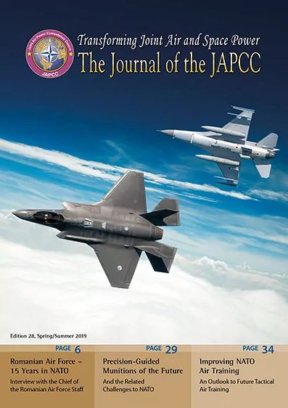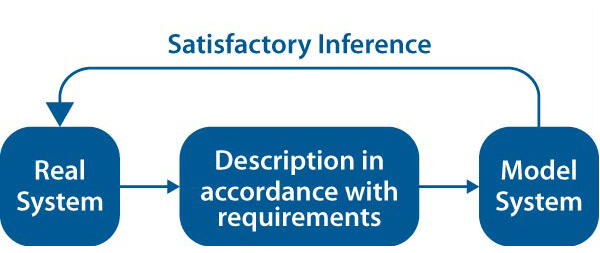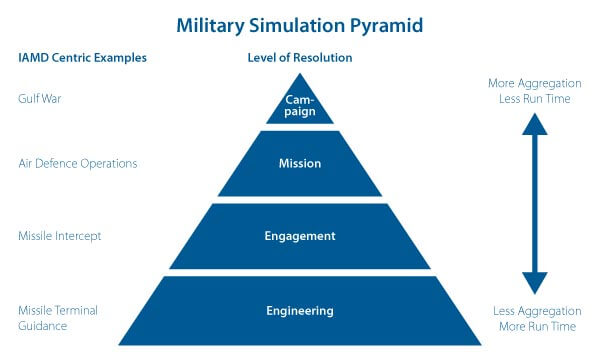Introduction
Modelling and Simulation (M&S) is nothing new, especially for training purposes in the military domain, although the extensive use of Information Technology (IT) has changed opportunities for the use of M&S. In order to be prepared for actual combat, soldiers need to train and exercise their skills to increase their chances of success. Since training with a real adversary is impossible for obvious reasons, simulations are used instead. In the information age, most people think of ‘simulation’ as computers, sophisticated mathematical equations and people in lab coats. But simulation is and can be so much more, that is, as long as the tools are correctly understood and used. The following article will look at M&S basics, how the military can benefit from simulation and why M&S tools need to be used quite carefully.
What is Modelling and Simulation?
Simulation is realistic modelling, as much as is possible, of events in reality1. In order to better comprehend simulation, it is beneficial to have a good understanding of the terms ‘modelling’ and ‘system’. According to P. Sanchez (2007)2, a ‘system’ is a set of elements interacting with each other, and a ‘model’ is a system which can be used as a surrogate for another system. Therefore, simulation is the process of using a model or models to study the behaviour of a system or system of systems. A system could be an aircraft or Surface Based Air and Missile Defence (SBAMD) unit, and an M&S equivalent could be an F-35 flight simulator or an S-400 mock-up3. There are numerous reasons why the use of models has advantages over using the original system. In terms of training, flight simulators are cheaper to operate than real jets, and S-400 mock-ups are easier to purchase and employ than the real system. However, there are also various reasons why we need to be careful in using these models. The development of a model follows a very deliberate path, and we need to know which demands the model needs to satisfy to qualify as a realistic model (see Figure 1). Hence, the use of the model outside of these demands will very likely not produce the desired results.
Figure 1: Generic development of a model.
The three framing parameters of model development are4:
- Resolution: The degree of detail and precision used in the model;
- Aggregation: The ability to group entities while preserving the effects of entity behaviour and interaction while grouped;
- Fidelity: The accuracy of the model.
Obviously, a model system cannot represent ‘all possible’ requirements, otherwise it would be the real system. The real and full experience of flying a Eurofighter can only be achieved by flying a Eurofighter, but perhaps the model only needs to satisfy a certain subset of ‘all possible’ requirements, like realistically representing switches and displays of an F-35 or PATRIOT engagement control station. Thus, the creator of a model needs to have, and be aware of, the finite set of requirements necessary to develop a satisfactory product. Consequentially, the resulting system model can only be successfully used to service these requirements. Any use of the simulation outside of these specifications will likely cause an unrealistic and unsatisfactory result. Worse yet, if unaware of the initiating requirements, it could provide an incorrect interpretation of the results. This, in turn, might result in erroneous conclusions or an unwarranted mistrust in simulation tools. So, simulation is an outstanding tool when used as intended, and within its design parameters.
Although a 3D model of an F-16 for a wind tunnel test or sandbox wargames technically qualify as a ‘simulator’ for M&S purposes, in the following paragraphs we will focus on characteristics of IT-aided simulations. In general, there are several taxonomies for classifying models and simulations. One of the most common categorizes the level of interaction with a human5:
- Live: A simulation involving real people operating real systems;
- Virtual: A simulation involving real people operating simulated systems;
- Constructive: A simulation involving simulated people operating simulated systems. Real people stimulate such simulations, but are not involved in determining the outcomes.
In execution, there can be mixed variants of all three of these categories to satisfy set demands. Simulations using Hardware in the Loop (HWIL) constructs6 are a hybrid of Live and Virtual, exploiting the benefits of both categories. Another way of distinguishing simulations is by the level of resolution. Figure 2 shows an exemplary projection of Integrated Air and Missile Defence (IAMD) on the military modelling and simulation pyramid.7 Higher levels on the pyramid allow for more aggregation, and lower level tend to show higher resolution.
Figure 2: Reflection of IAMD on the military M&S pyramid.
Some simulations can be executed in a continuous and dynamic fashion in real time, representing regular operations, while others are done in a more analytical fashion (e.g. using the Monte Carlo method8) mostly in non-real-time with little observability. For that, it is essential the simulator adequately process all qualitative and quantitative inputs necessary to produce an output with the desired value. All parts of the simulation need to be fine-tuned to achieve the desired result. The inputs must match the model’s resolution and fidelity to achieve usable outputs.
Another distinguishing parameter of many simulators is their capability of being embedded in a network with other simulators, or used in a standalone fashion. For NATO IAMD, highly networked operations are inherently crucial. Hence the capability of accurately portraying that capability in an M&S environment is essential. To be able to connect multiple simulators, some of their input/output and means of transmission need to be standardized. Obviously, operational Data Links (e.g. Link-169 or JREAP-C10) are available, but a data exchange format is also necessary that allows a gainful stimulation of all connected simulators. Currently, two standards are widely used: Distributed Interactive Simulation (DIS) (Distributed Interactive Simulation v7 IEEE Standard 1278.1) and High-Level Architecture (HLA) (High Level Architecture IEEE Standard 1516). DIS was developed in the early 1990s and was supposed to be succeeded in NATO by HLA in 1998. Instead, DIS was amended for new demands in 2010 (e.g. Direct Energy effects or Mode 5 Identification Friend or Foe [IFF]) and is still in use by the Alliance. Regardless of which standard is used, the simulation link needs to be able to support all current and future demands, so it has to be updated continuously so that the simulations will not be stifled by an out-of-date interface.
A conglomerate of simulators working together can also be seen as one big simulation with high resolution and low aggregation, but bound by the same fundamental question. Does this ‘super’ simulation fulfil all requirements to achieve sufficient accuracy for the anticipated product? Just because it is technically feasible, does not mean it warrants the effort to do so, when a different simulator might give better results. For campaign-level analysis, constructive models with a higher level of aggregation and statistically portraying lower level units are more suitable than large networks of individual simulators.
Also, and especially with military simulators, the classification of input/output data and the model itself are fundamental aspects which will have a significant effect on how the simulator can be employed. For NATO, this requires information sharing agreements be in place before the whole effort can be initiated.
M&S in Support of NATO Education, Training, Exercise and Evaluation
The baseline education and training of national capabilities is the responsibility of each Alliance nation. NATO’s concept of Education, Training, Exercise and Evaluation (ETEE) is a logical build-up from individual training to collective exercises, concluding with evaluations to reliably create and sustain the necessary joint and synergetic capabilities and capacities for NATO operations.
During this whole process, simulators can not only contribute significantly to save time and resources, therefore increasing overall efficiency, but also create new training options that would otherwise not be available. Simulation allows NATO to reduce ETEE efforts to necessary focus areas. This could be done with real systems that possess a simulation environment with all essential models and interfaces, or with dedicated simulation tools. If an operator needs to learn or improve his skill on his respective console, simulation tools can take care of everything behind the Human-Machine Interface (HMI). For example, for console training of a Tactical Control Officer (TCO) of a SBAMD unit, it is not necessary to use a fully-employed weapon system, and for a pilot, it is not required to have the HMI 10,000 metre in the air. For the console training of higher-level headquarters, it is not necessary to employ all subordinate units, as most units can be portrayed mainly with adequate simulators or models and reduced to a needed minimum.
One of the core paradigms of military training is ‘train as you fight’. Since the ETEE environment should be a sufficient depiction of real-world circumstances, it should also reflect full NATO missions, or coalitions of the willing, with or without non-NATO nations. Here, classification issues become relevant very quickly. In other words, weapon systems, simulators and networks might need to be able to work in various classification environments. Currently, NATO has the option to use the Combined Federated Battle Laboratories Network (CFBL Net) for simulation purposes outside of the NATO secret network as a standing capability for IAMD training. A simulation tool which reveals information with higher classification or too many technical details might only be suitable for a small subset of audiences. This implies that not only national demands for models need to be met but also all potential networked arrangements as well. For an exercise like Joint Project Optic Windmill (JPOW), it is of little importance to have a high-fidelity, six-degrees-of-freedom depiction of an interceptor missile transposed on the Link-16 and DIS network. Lower fidelity (e.g. three degrees of freedom models, sanitized flight paths) with a statistical representation below a releasable threshold are sufficient and help the integration of all anticipated players. A portrayal of all entities in the same simulated threat environment is one of the main benefits. This also helps in designing the network required for such an exercise. Apart from simulation-specific issues, the integration design should reflect the actual mission requirements of such a player audience quite well, which should help when doing the same thing in a real mission. The connection of real and simulated systems in one distributed network will create the needed synergy without the need for a centralized system deployment. Furthermore, it reduces the need for real weapon systems, which are a scarce commodity, to a necessary minimum. Of course, the systems/simulators require network connectivity with adequate bandwidth, latency and encryption.
Depending on the ETEE audience (e.g. a Unit-level Force Evaluation or Joint Force Command Major Joint Operations exercise), it is essential to define the framework and focus of what needs to be simulated to find the appropriate model(s). If we are still in the phase of learning, improving or experimenting, simulation creates outstanding options for trial-and-error, learning-by-doing and step-by-step improvements in an environment of high attrition or overmatch. Besides, in a simulation, it is easier to change the circumstances (e.g. doubling the red forces or increasing/decreasing own resources) to give the training audience the broadest spectrum possible. This helps identify how robust certain procedures are, and to identify the need for contingency plans.
Not only can M&S representations of enemy forces be the easiest way of interfacing with them outside of the battlefield, but surely the most adaptable, so that these models can be used for a broad spectrum of use-cases. In general, it is much easier to portray adversary forces within a defined, controlled and repetitive environment. From testing and refining Tactics, Techniques and Procedures (TTPs), to simulations with a more experimental character, the following exemplary disciplines can be supported by M&S tools:
- developing policy;
- analyzing resilience of own capabilities;
- identifying capability gaps;
- optimizing defence plan/design robustness.
Also, a conflict with high attrition rates on both sides can only be trained within a simulated environment. Since peer, near-peer and proxy conflicts appear to be or become the current focus, an M&S environment seems to be the safest, cost-effective and best way of evaluating such situations.
Other Areas M&S can Support and Create Synergy
As stated before, simulation is nothing new and is already present in current various NATO Air Command and Control (C2) processes. For IAMD, a simulator is used to evaluate potential defence designs. As a recent example, for a current threat study, NATO used a campaign and mission level simulator to validate standing plans and identify potential gaps or weak points. A prevalent discussion in the M&S community is about what kind of weapon system data is needed (red and blue) to draw viable assumptions and conclusions. Since most defensive weapon systems and enemy weapons data underlie national disclosure restrictions, it is complicated to create a high-fidelity database for NATO simulations. However, just because the data does exist to support a certain degree of fidelity, does not imply that it is actually needed to create the desired output.
M&S can support the procurement process of new systems from the initial decision to its final integration. Integrating and optimizing a model, and reflecting identified military needs in a simulated operational environment with representative models of existing systems, can support refining the actual requirements. It has proven beneficial to have users hands-on during the development to stay true to these requirements. Also, through the use of simulators, the development of operational concepts and TTPs can be started before the hand-over of the system to the user occurs. By developing and amending such models right from the beginning, they can be used later on for other purposes mentioned above.
Simulation and Artificial Intelligence
Artificial Intelligence (AI) is one of the current buzzwords in computer science and one of the leading trends of ongoing global research. In the context of M&S, it can be described as a model for problem-solving and decision-making in various processes. The problems are not being solved based on predetermined algorithms, but rather based on a dedicated learning process that creates a model for optimized decision-making. Of course, M&S environments can serve to train certain AIs. Currently, NATO is discussing how to incorporate AI in AirC2. Once it is incorporated, it must be reflected in any model or simulation of NATO AirC2. Otherwise, the model will rarely produce realistic results. For the portrayal of adversary forces, AI could be trained to reproduce adverse behaviour in a controlled fashion, which could, for example, reduce the need for large red force player groups during exercises. Since it can be assumed that potential adversaries are also developing AI for their military purposes, and the employment of AI might create a new paradigm in warfare, this also needs to be reflected in our M&S to have a successful depiction of the enemy.
Conclusion
M&S is much more than just another beneficial tool for affordable and realistic IAMD training. It is a keystone element for the overall mission success of NATO and the gateway for affordable and realistic training. The proper use of M&S can support various IAMD facets; from system procurement to operational evaluations. For the Alliance, to be able to use M&S to a maximum extent, several things need to be available:
- A clear understanding, on all applicable C2 levels, of simulation requirements and/or possibilities:
- resolution, aggregation and fidelity;
- quality/quantity of input/output, observability;
- thorough description of model accuracy, limitations and possibilities.
- Flexible and adaptable simulation environments:
- data link networks and up-to-requirement simulation link networks;
- options for distributed simulation and integration.
- Up-to-date NATO simulation standards:
- simulator network interfaces;
- standards for input and output formats.
- Information sharing concepts, tailored to simulation demands:
- What is needed?
- What can be provided?
In general, the use of M&S tools for NATO has to be a coordinated effort between NATO, NATO nations and industry. Also, knowledge about the general use, benefits and limitations of simulation needs to be broadly spread throughout NATO to increase the correct usage of M&S, and to take full advantage of its benefits. For NATO ETEE alone, it could create a more cost-effective, streamlined environment, always moulded for the respective training audience.














